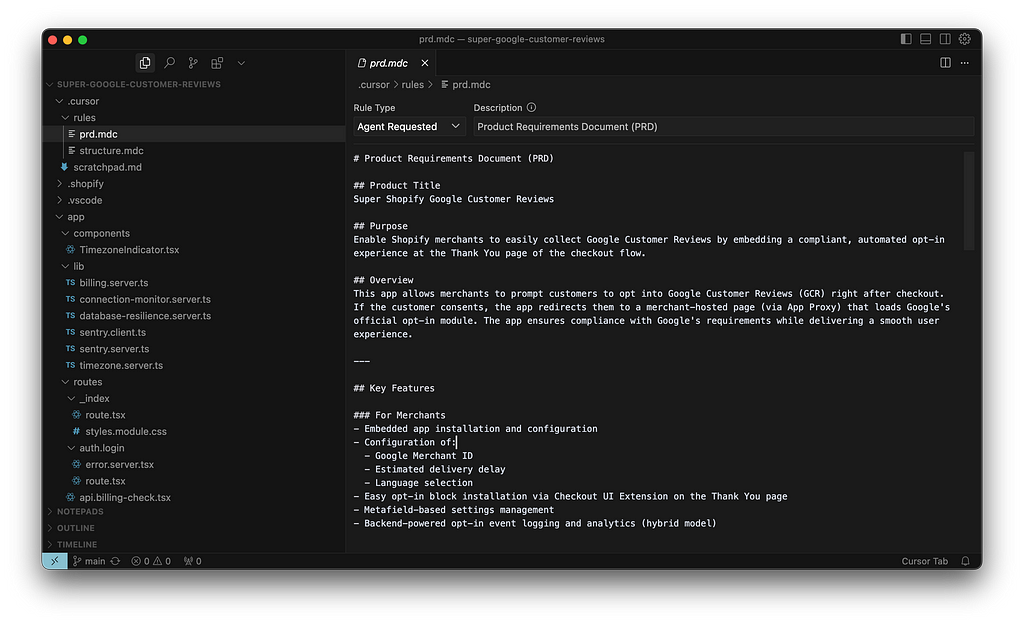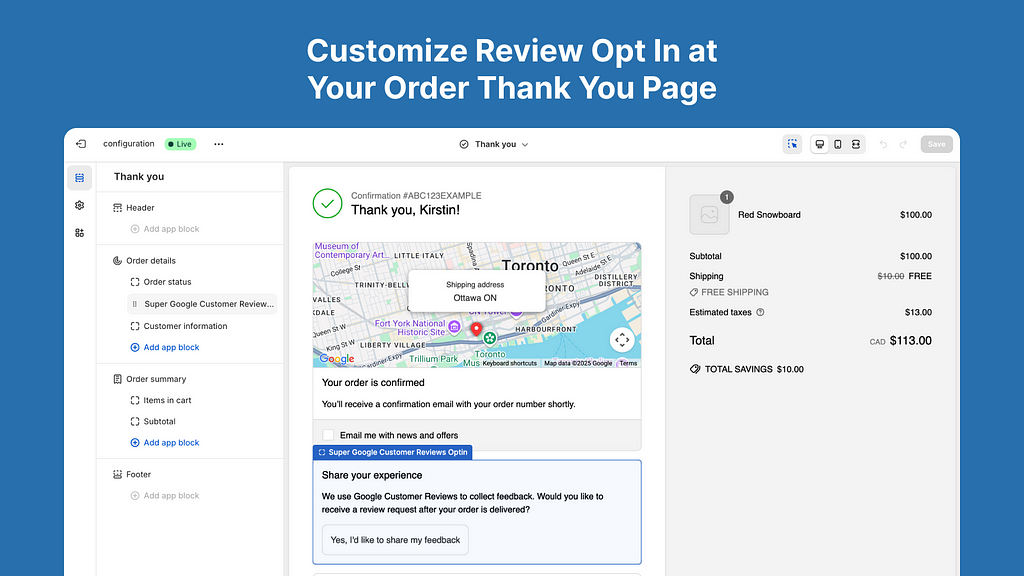
How I Built a Shopify App in a Weekend — as a Designer with AI
From product designer to app store publisher in 72 hours — and what that taught me about design, code, and creativity.
I’ve spent nearly a decade in Product Design— designing for fintech, startups, and complex enterprise systems. I’ve helped shape products from early ideation to polished rollouts. But launching something truly mine — fully designed, built, and published by me — was a milestone I hadn’t yet hit. Not fully. Not publicly.
That changed one weekend, when curiosity met constraint, and AI gave me the last push I needed.
This is the story of how I used design thinking, two AI tools, and a few nights of intense focus to go from idea to Shopify App Store — without a dev team or a startup budget.
The Problem: Checkout Scripts Are Disappearing — and So Are Google Reviews
Google Customer Reviews helps merchants build trust through post-purchase surveys. It’s a small pop-up, but it matters: it boosts credibility and brings in high-intent traffic.
For years, Shopify merchants have relied on Checkout Scripts to trigger the Google Customer Reviews opt-in. But with Shopify planning to deprecate Checkout Scripts in the coming months in favour of Checkout UI extensions — and suddenly, thousands of merchants lost a simple way to collect reviews.
I knew the pain firsthand from merchants I’d worked with. There was no out-of-the-box solution. And every workaround felt fragile.
My Goal: Build a Native, Compliant, No-Code App for Merchants
I wanted to create a seamless experience:
- One-click opt-in on the thank-you page
- Fully Shopify-native: app block or UI extension
- Google-compliant: triggering their opt-in module with real order data
- Zero code required from the merchant
It had to feel like it was part of Shopify. It had to just work.
My Process: Design Thinking + AI Execution
I didn’t start with code. I started with clarity — and a whiteboard filled with questions.
How do I trigger a third-party script in a sandboxed environment? How do I do it without the merchant writing a single line of code? What would a real, Shopify-native experience feel like?
That’s when I turned to AI — not to take over the process, but to help accelerate it. Here’s how we tackled it together:
Step 1: Understand
The first few hours were just conversations with ChatGPT. I explained the problem the way I’d onboard a junior designer. I asked it to act like a technical PM, then a Shopify support agent, then a developer.
Together, we unpacked Shopify’s new Checkout Extensibility model, reviewed limitations of post-purchase extensions, and dug through Google’s opt-in documentation line by line.
This wasn’t prompting — it was pair ideation.
Step 2: Explore
We mapped out different implementation paths: Post Purchase extensions, the Thank You page, and Proxy-based rendering.
Every idea triggered new questions. How can we securely pass order data without JavaScript? Can a Proxy simulate user interaction for compliance?
Eventually, we narrowed it down to a hybrid model: get consent within the extension, then simulate the Google pop-up via a secure proxy on the merchant’s domain.
Step 3: Define
This is where my design background took over. I created the customer and merchant journeys. I mapped user flows, listed edge cases, and documented constraints. ChatGPT helped me turn these into a PRD, a roadmap, and even a tech stack overview.
AI turned my thoughts into structure.

Step 4: Build
Then I moved into Cursor — a dev tool that lets you build side-by-side with AI. It felt like having a co-pilot that already knew Shopify’s design language.
I chose Remix because it’s the official framework for modern Shopify apps, and made sure the design followed Shopify’s Polaris Design System — not just for polish, but because I wanted the app to feel truly native to the Shopify ecosystem.
Every bug became a conversation. Every idea, a prototype.
Step 5: Iterate
It didn’t work on the first try. Or the second. But each version got sharper:
- The first draft was overly ambitious — everything worked in theory, nothing in practice.
- The second was bloated — too many assumptions, too soon in production.
- The third was lean, local-first, and simple. It shipped.
Each time, I learned faster. I built smarter. I scoped tighter. And the AI got better at anticipating what I needed — because I got better at defining it.

The Outcome: From Idea to App Store
By Sunday night, I had something real. Not just a side project or a dev folder — but a live, public app that anyone could install. It was more than I imagined when I opened that blank file on Friday.
Here’s what came out of it:
- A Shopify App Store listing that merchants could actually use
- A seamless customer opt-in experience that felt like part of Shopify
- A settings dashboard where merchants could manage preferences, no code needed
- Basic analytics built in, so I could learn how it was working in the real world
All of this — concept to app store — built by one designer working alongside AI.
It wasn’t magic. But it felt like the future.
What I Learned
No amount of AI can fix a vague goal. That was the first big lesson.
I went in thinking AI would just “write the code” — but what I found is that it needs direction, context, and clarity. The better I understood the problem, the better it could help me solve it.
This experience also changed how I see myself.
Before this, I wasn’t sure if I was “technical” enough to build something end-to-end. Now I don’t think in terms of technical or non-technical — just problems and possibilities.
More than anything, I was reminded that: It was about expanding what I thought was possible as a solo designer.
What’s Next
This is just the start.
With the app live, I’m now looking to:
- Add analytics and A/B testing to understand what’s working
- Support more languages to help merchants globally
- Keep writing about what it means to design and build with AI
But more importantly, I want to help more designers realise they can do this too.
We’re not just wireframing anymore. We’re building real products — faster, smarter, and more independently than ever.
Design isn’t just part of the process. With AI, it can lead it.
If you’ve ever thought, “I wish I could just build it myself,” I hope this shows you: you probably can. The tools are here. You already have the mindset. And the AI is waiting.
👋 Let’s connect on LinkedIn, explore the live app, or chat design systems + AI.
How I Built a Shopify App in a Weekend — as a Designer with AI was originally published in UX Planet on Medium, where people are continuing the conversation by highlighting and responding to this story.